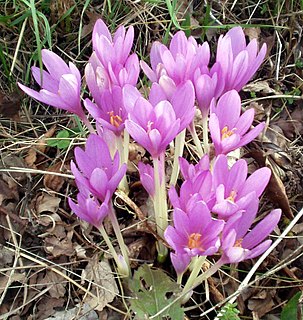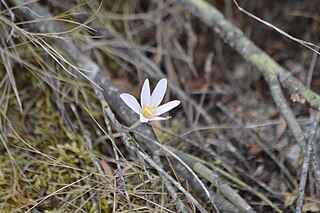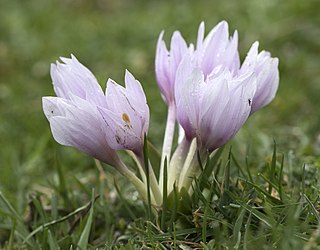
Colchicum is a genus of perennial flowering plants containing around 160 species which grow from bulb-like corms. It is a member of the botanical family Colchicaceae, and is native to West Asia, Europe, parts of the Mediterranean coast, down the East African coast to South Africa and the Western Cape. In this genus, the ovary of the flower is underground. As a consequence, the styles are extremely long in proportion, often more than 10 cm (4 in). All species in the genus are toxic.

Colchicaceae is a family of flowering plants that includes 15 genera with a total of about 285 known species according to Christenhusz and Byng in 2016.

Colchicum autumnale, commonly known as autumn crocus, meadow saffron, or naked ladies, is a toxic autumn-blooming flowering plant that resembles the true crocuses, but is a member of the plant family Colchicaceae, unlike the true crocuses, which belong to the family Iridaceae. The name "naked ladies" is because the flowers emerge from the ground long before the leaves appear. Despite the vernacular name of "meadow saffron", this plant is not the source of saffron, which is obtained from the saffron crocus, Crocus sativus – and that plant, too, is sometimes called "autumn crocus".

Sternbergia is a genus of Eurasian and North African plants in the Amaryllis family, subfamily Amaryllidoideae.

Colchicum speciosum is a species of flowering plant in the family Colchicaceae, native to mountainous areas of northern Turkey, the Caucasus and northern Iran. Growing to 18 cm (7 in) tall by 10 cm (4 in) wide, it is an herbaceous perennial growing from corms. C. speciosum blooms in the fall, producing reddish/violet flowers on stems up to 30 centimetres (12 in) tall without any leaves present. The strap-like leaves grow in the spring, then yellow, wither and die back as summer progresses. The flowers strongly resemble those of the crocus, the familiar spring-flowering bulb; hence the common name autumn crocus which is applied to this and other colchicum species. However the two genera belong to different families; and there is in fact an autumn-flowering crocus species, Crocus sativus, the source of the spice saffron. By contrast, all parts of Colchicum speciosum are toxic if ingested.

Colchicum cilicicum, the Tenore autumn crocus, is a species of flowering plant in the Colchicaceae family. A bulbous perennial, it bears deep rose-lilac flowers in late summer, with barely any chequered pattern on the petals (tessellation). It has a very noticeable white stripe down the centre of each petal, which gives it a star-like appearance at the base. The flowers tend to stand up to weather better than other colchicum blooms. The flowers appear before the strap-like leaves, giving this and other colchicum species the common name “naked lady”. Although colchicums are called “autumn crocuses” they belong to a different family than true crocuses. There are in fact autumn-flowering species of crocus such as Crocus sativus, which is the source of the spice saffron. Colchicum cilicicum, by contrast, is toxic if eaten.

Colchicum macrophyllum has large, funnel-shaped flowers in the fall with much tessellation throughout the bloom. The colour is rosy-purple and white. The leaves that it produces in the spring are large, up to 16" (40 cm) long, among the largest of all colchicum species.

Colchicum corsicum is a species of flowering plant in the Colchicaceae family. It is native to the islands of Corsica and Sardinia in the Mediterranean.

Colchicum kotschyi is a species of flowering plant in the Colchicaceae family. It is native to Iran, Iraq and Turkey. It blooms relatively early for an autumn flowering colchicum, as early as August. The flowers open to a pink-purple colour, but white flowered specimens are common in the wild. The plant reaches up to 2 m (6") tall and grows well in sunny, warm locations.

Colchicum boisseri is member of the flowering plant family Colchicaceae native to southern Greece and south-western Turkey but cultivated elsewhere as an ornamental. The species is unique for its spreading, rhizomatous bulbs. It blooms well with 5 cm (2") blooms in a bright cherry pink. The stamens are yellow. The flowers have no tessellations, only a white line down the centre of each petal. It is named after botanist Pierre Edmond Boissier.
Colchicum lingulatum is a species of flowering plant in the Colchicaceae family. It is native to north-western Turkey and to Greece.
Colchicum micranthum is a species of flowering plant in the family Colchicaceae. It is native to Turkey with nearly white flowers barely 2 cm (.75") tall. It produces a series of blooms throughout the fall. The leaves follow the flowers, and are usually 3–5 in number.
Colchicum zahnii is a member of the flowering plant family Colchicaceae that is native to southern Greece. It blooms in mid-fall from rhizomatous corms. The flowers can be variable colored, being a pale purple-pink to white and are often held wide open. The leaves are produced at flowering time and usually number 2 to 3. This species is similar to Colchicum boissieri in that the corms grow into large patches, rather than tight clumps like Colchicum speciosum or Colchicum autumnale.

The national symbols of Hungary are flags, icons or cultural expressions that are emblematic, representative or otherwise characteristic of Hungary or Hungarian culture. The highly valued special Hungarian products and symbols are called Hungaricum or Hunnerisms.

Colchicum bulbocodium, the spring meadow saffron, is a species of alpine bulbous plant native to mountain ranges across Europe from the Pyrenees to the Caucasus.

Colchicum variegatum, common name Κολχικό το ποικιλόμορφο or Güz Acıçiğdemi, Sürincan is a plant species native to Greece and Turkey but cultivated in many other places.

Colchicum ritchii, or the Egyptian autumn crocus, is a plant species native to the southeastern Mediterranean east to the Arabian Peninsula.

Colchicum szovitsii is a species of flowering plant in the family Colchicaceae, native from eastern Bulgaria to northwestern Jordan and Iran. It was first described in 1835.

Colchicum luteum, the yellow colchicum, is a species of flowering plant in the family Colchicaceae, native to Central Asia, Afghanistan, Pakistan, the western Himalayas, and Tibet. The only yellow-flowered member of its genus, a number of cultivars are available, including 'Golden Baby' and 'Vahsh'.
















